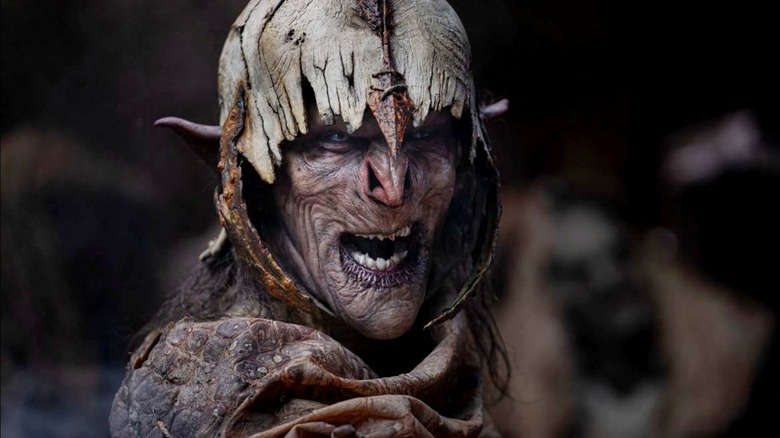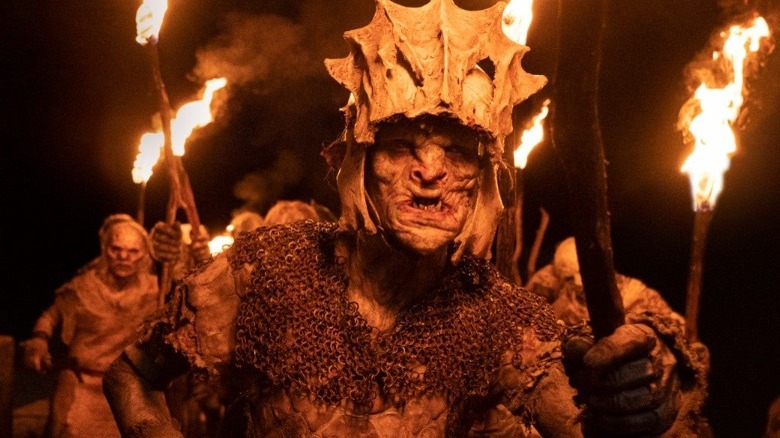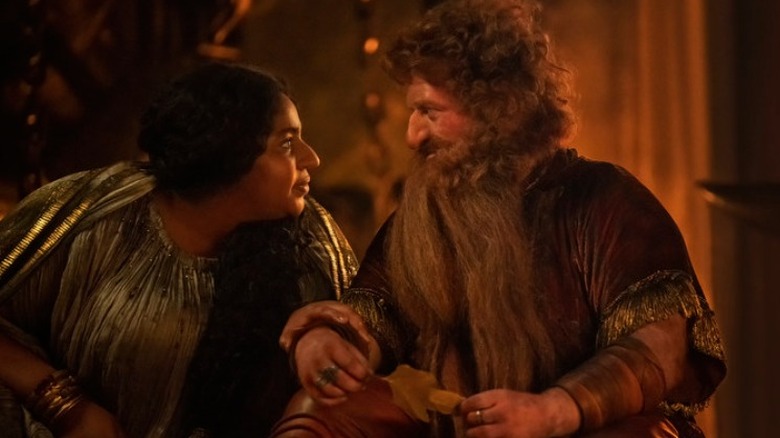The Lord Of The Rings' Orcs Got A Behind-The-Scenes Upgrade For The Rings Of Power
In a CGI-heavy pop culture world, you'd think a production as pricey as "The Lord of the Rings: The Rings of Power" would go all-in on the visual effects. But although the new fantasy show's visuals are clearly top of the line, there's apparently also more practical work going on behind the scenes than meets the eye.
"Because there are hundreds of productions that are heavy on visual effects, and you can see it, the human eye is getting better and better and knows what is real and knows what isn't," the show's prosthetics department head Jamie Wilson recently explained to IGN.
Therefore, the team behind "The Rings of Power" decided early on that they wanted to make the show look as real as possible, using CGI as an enhancement but not the baseline for much of this version of Middle-earth. Plus, Wilson notes, prosthetics have also improved greatly since the cast of Peter Jackson's original trilogy donned their dwarf noses and orc scowls.
A revolution in prosthetics
"The orcs in particular, apparently, got quite the behind-the-scenes facelift for the new series. You go back 20 years and we used a basically foam latex, which is like a porous-y kind of rubbery, spongy material with a smooth or whatever textured surface," Wilson says, describing the orc design elements from Jackson's films. The design was "great at the time," but near the end of production, a new form of silicon prosthesis came around that made the process much easier on Gimli actor John Rhys-Davies towards the end of filming.
The prosthetics manager says the ears, nose, and assorted pieces in "The Rings of Power" are made of "encapsulated silicon," which is much more moveable than previous materials. "It also gets the same temperature as their skin. And you can see the translucency and then you gently paint on the top of it, a bit like doing makeup on a human," Wilson explained to IGN. The old version, in comparison, was apparently more like painting layers atop rubber.
According to Galadriel actor Morfydd Clark, the show's in-depth practical effects are among the most surprising behind-the-scenes elements. She told Collider that the actors were "really lucky that the orcs are all practical," although it sounds like she wouldn't trade places with orc actors, whose call time is earlier than everyone else's. "Also a surprise was the fact that that means that you're getting in there at 7:00 AM being like, 'Gosh, it's so early,' and the orcs have been there since half midnight getting their prosthetics put on," said Clark.
Practical effects teams went all out
Several actors involved in "The Lord of the Rings: The Rings of Power" have highlighted planning done by assorted practical effects teams that made it easy to perform opposite assorted Middle-earth beings without feeling hindered by the visual distance between the on-set experience and the series' CGI-enhanced vision. In an interview with /Film, Robert Aramayo and Owain Arthur noted the many ways the crew worked to ensure they could act face to face while still capturing the size difference between the elf and dwarf characters. The team was "just very accommodating to get the best out of us," Arthur noted, and it sounds like the same held true for the orcs.
"We did a lot of planning so that we knew in advance which performers would be closest to camera," executive producer Lindsey Weber told IGN of larger-scale orc scenes that required post-production special effects. Weber added, "It was so important to us to have them all be as in camera as they could be to get everyone in the mood and make it feel real as we were shooting." She also notes that the prosthetics team worked extra hard to ensure the prosthetics around actors' mouths were "thin and nimble" to allow for maximum emotion from the actors, as well as comfort during long days of wear.
You can see the results of the prosthetic work for yourself: "The Lord of the Rings: The Rings of Power" is available on Prime Video, with new episodes each Friday.


